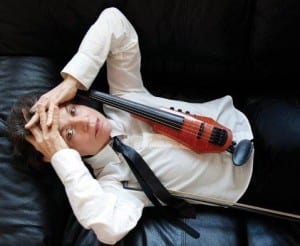Born in 1947, Laurie Anderson is a multi talented performer, describing herself as visual artist, composer, poet, photographer, filmmaker, electronics whiz, vocalist, and instrumentalist. She is one of America’s most renowned, inventive pioneers. She is best known for her multimedia presentations and innovative use of technology. She has toured the United States and internationally with performances ranging from simple spoken word to large multimedia events. She creates art defined not by genre but by inspiration and technology. This approach to her work results in performances which are vast in style whilst in keeping with her desires for exploring the disjointed and mesmerizing world we live in.The story is the focus for Anderson and her genre-defying works for the stage blend together the use of sound and movement, image and spoken word in immersive, dreamlike productions. Sound and music is one of her most iconic features, particularly the use of violin, as Anderson states “for me the violin is the perfect alter ego. It’s the instrument closest to the human voice, the human female voice” (2000, p77). Her image is often associated with the violin as if she and the violin are inseparable. To create new sounds she has made many modifications to the violin she plays including installing a speaker inside the violin, filling it with water and even burning it.
Laurie Anderson returns to Santa Barbara, Lucie Jansch, (2012)
United States is one of her biggest pieces which she started writing in 1979 at a time when she was spending a lot of time out of America due to performances in Europe. It was eventually performed in 1983. The performance was created in response to her friends, who asked how she could live in a high tech cultural wasteland like America. United States is a compilation of material from over a decade of songs, texts, images, film footage all sliced together in an eight hour production. It covered themes such as transportation, politics, money and love. Her song, O superman, which was a hit in the charts, was at the heart of the show and was wrote as an appeal for help against the manipulation of the controlling media culture. When she performed this song, her left arm created a giant shadow projection on the screen behind her whilst she played the keyboard with her other hand.
Three of her solo performances turned into a trilogy of work. The trilogy included Happiness, The End of the Moon and Dirtday.
Happiness, was a 100 minute monologue which consisted of precision story telling which was mostly autobiographical with some of her poetic lyrics woven in which discussed themes such as hatred so the title was quite ironic. She reads short anecdotes about her life and observations from the past year. She was interested in the use of silence and researched into this through physical experiences living with an armish family and visiting a group of silent Buddists as they sail down the river of Utah. She links her interest of silence to the multimedia usage in her work as there is a difference between human silence and technological silence. Happiness enables the audience to learn more about Laurie as a person but consequently tells us a lot about ourselves. This was one of her most personal pieces told through a balance of speech and song. In 2002, Anderson was appointed the first artist-in-residence of NASA out of which she developed her solo performance “The End of the Moon” which premiered in 2004 and toured internationally through 2006. Her idea for Dirtday originally started as a music based piece with the exploration of her violin. Considering all the modifications she has made to her violins, she wanted to fully explore its capabilites and possiblities. Throughout her devising process however, other sounds and words were added and the violin then supported the stories instead. Laurie started out with political themes, then the stories kind of veered off into different theories of evolution and ideas about why we dream, which nobody actually knows. Laurie said she “found it so incredible that you spend a third of your life dreaming, and nobody knows what you’re doing or why you’re doing it”(Vitoschnabel, 2012). Again her work returns to such themes as religion, politics and the human condition.
Anderson’s words and lyrics are very powerful in her performances alongside the images she uses as part of her performances. In a quote by Anderson she states,” One of my jobs as an artist is to make contact with the audience and it has to be immediate” (Anderson in Goldberg, 2000, p.11). Rather than shocking her audiences as would have been done in previous tactics of live art, she instead adopts a more subtle approach to change and influence their minds. In United States for example, she projected thousands of images along with streams of words some of which were sung. Anderson makes comments on big issues for her country and the world through her performances, as Anderson states, “But my goal as an artist isn’t to change the world. My goal is to describe it” (Anderson, 2012).
-Below is a link to my presentation on Anderson-
Anderson’s mixture of speech, song and multi-media is something which has really interested and influenced me and I hope to include as a structure for my own solo performance.
Works Cited
Anderson, L (2012) Q&A with Laurie Anderson [interview online] VITO SCHNABEL. Available from http://vitoschnabel.com/articles/qa-with-laurie-anderson Interviewed by Mark Baumgarten, 27th September.
Goldberg, Roselee (2000) Laurie Anderson Harry N. Abrams: United States

You have a lot of catching up to do. We are half way through the teaching programme and you have made only one entry. It’s a really good entry, but there needs to be a lot more. Discipline yourself to make regular and considered entries. You will do well if they are all of this quality.